目录
基于注解实现Aop(推荐)
什么是AOP
AOP(Aspect Oriented Programming)意为:面向切面编程。作用是在不影响原业务类的基础上实现了增强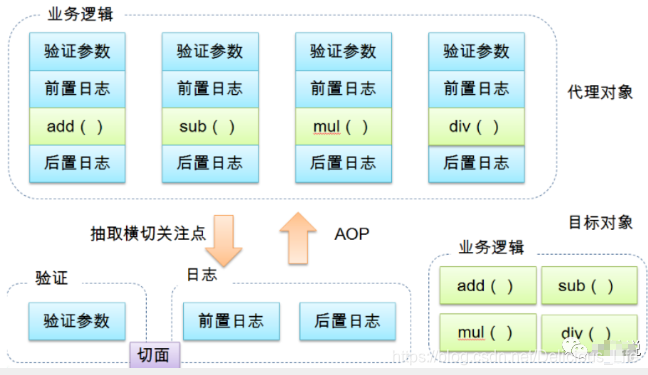
Aop在Spring中的作用
需要了解的名词
-
横切关注点:即某一个要加的功能。跨越应用程序多个模块的方法或功能。即是,与我们业务逻辑无关的,但是我们需要关注的部分,就是横切关注点。如日志 , 安全 , 缓存 , 事务等等 ....
-
切面(ASPECT):这个功能的类名叫什么。横切关注点 被模块化 的特殊对象。即,它是一个类。
-
通知(Advice):类中的方法。切面必须要完成的工作。即,它是类中的一个方法。
-
目标(Target):被通知对象。
-
代理(Proxy):生成的代理类。向目标对象应用通知之后创建的对象。
-
切入点(PointCut):在哪个地方执行。切面通知 执行的 “地点”的定义。
-
连接点(JointPoint):在哪个地方执行。与切入点匹配的执行点。
-
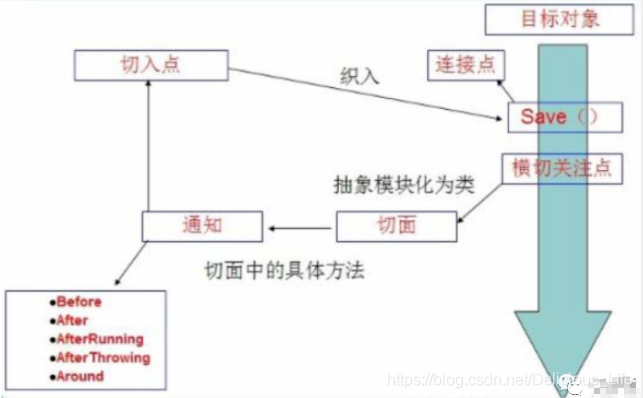
AOP中内置了5种通知类型,即五种方法类型
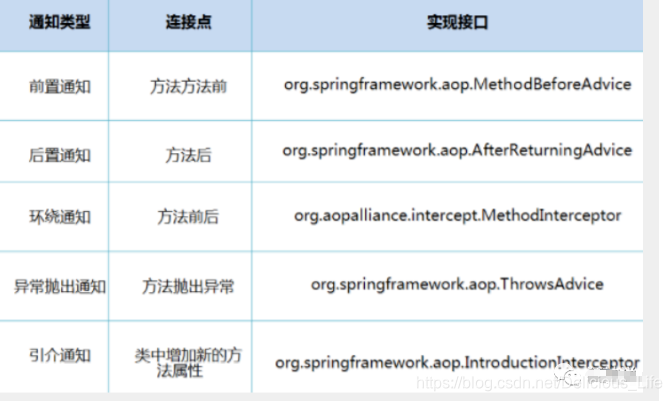
基于SpringApi实现AOP
1.导包
<!-- https://mvnrepository.com/artifact/org.aspectj/aspectjweaver -->
<dependency>
<groupId>org.aspectj</groupId>
<artifactId>aspectjweaver</artifactId>
<version>1.9.4</version>
</dependency>2.写Service接口
public interface UserService {
public void add();
public void delete();
public void update();
public void search();
}3.Service的实现类
public class UserServiceImpl implements UserService{
@Override
public void add() {
System.out.println("增加用户");
}
@Override
public void delete() {
System.out.println("删除用户");
}
@Override
public void update() {
System.out.println("更新用户");
}
@Override
public void search() {
System.out.println("查询用户");
}
}4.然后我们新建一个切面,也就是要增加的具体功能类
public class Log implements MethodBeforeAdvice {
//method : 要执行的目标对象的方法
//objects : 被调用的方法的参数
//Object : 目标对象
@Override
public void before(Method method, Object[] objects, Object o) throws Throwable {
System.out.println( o.getClass().getName() + "的" + method.getName() + "方法被执行了");
}
}5.再来一个切面
public class AfterLog implements AfterReturningAdvice {
//returnValue 返回值
//method被调用的方法
//args 被调用的方法的对象的参数
//target 被调用的目标对象
@Override
public void afterReturning(Object returnValue, Method method, Object[] args, Object target) throws Throwable {
System.out.println("执行了" + target.getClass().getName()
+"的"+method.getName()+"方法,"
+"返回值:"+returnValue);
}
}6.新建一个applicationContext.xml文件负责去Spring的文件中注册 , 并实现aop切入实现 , 注意导入约束 .
<?xml version="1.0" encoding="UTF-8"?>
<beans xmlns="http://www.springframework.org/schema/beans"
xmlns:xsi="http://www.w3.org/2001/XMLSchema-instance"
xmlns:aop="http://www.springframework.org/schema/aop"
xsi:schemaLocation="http://www.springframework.org/schema/beans
http://www.springframework.org/schema/beans/spring-beans.xsd
http://www.springframework.org/schema/aop
http://www.springframework.org/schema/aop/spring-aop.xsd">
<!--注册bean-->
<bean id="userService" class="com.lt.Demo.UserServiceImpl"/>
<bean id="log" class="com.lt.Demo.Log"/>
<bean id="afterLog" class="com.lt.Demo.AfterLog"/>
<!--aop的配置-->
<aop:config>
<!--切入点 expression:表达式匹配要执行的方法-->
<aop:pointcut id="pointcut" expression="execution(* com.lt.Demo.UserServiceImpl.*(..))"/>
<!--执行环绕; advice-ref执行方法 . pointcut-ref切入点-->
<aop:advisor advice-ref="log" pointcut-ref="pointcut"/>
<aop:advisor advice-ref="afterLog" pointcut-ref="pointcut"/>
</aop:config>
</beans>测试
public class MyTest {
@Test
public void test(){
ApplicationContext context = new ClassPathXmlApplicationContext("applicationContext.xml");
UserService userService = (UserService) context.getBean("userService");
userService.search();
}
}
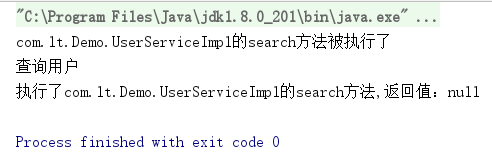
Spring的Aop就是将公共的业务 (日志 , 安全等) 和领域业务结合起来 , 当执行领域业务时 , 将会把公共业务加进来 . 实现公共业务的重复利用 . 领域业务更纯粹 , 程序猿专注领域业务 , 其本质还是动态代理 .
基于自定义类来实现Aop
1.我们自己定义一个切入类
public class DiyPointcut {
public void before(){
System.out.println("---------方法执行前---------");
}
public void after(){
System.out.println("---------方法执行后---------");
}
}2.去Spring中配置
<bean id="diy" class="com.lt.Demo.DiyPointcut"/>
<!--aop的配置-->
<aop:config>
<aop:aspect ref="diy">
<aop:pointcut id="diyPonitcut" expression="execution(* com.lt.Demo.UserServiceImpl.*(..))"/>
<aop:before pointcut-ref="diyPonitcut" method="before"/>
<aop:after pointcut-ref="diyPonitcut" method="after"/>
</aop:aspect>
</aop:config>3.测试
@Test
public void test(){
ApplicationContext context = new ClassPathXmlApplicationContext("applicationContext.xml");
UserService userService = (UserService) context.getBean("userService");
userService.search();
}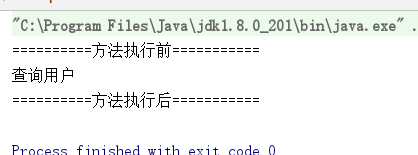
基于注解实现Aop(推荐)
1.编写一个注解实现增强类
package com.lt.Demo;
import org.aspectj.lang.ProceedingJoinPoint;
import org.aspectj.lang.annotation.After;
import org.aspectj.lang.annotation.Around;
import org.aspectj.lang.annotation.Aspect;
import org.aspectj.lang.annotation.Before;
@Aspect
public class AnnotationPointcut {
@Before("execution(* com.lt.Demo.UserServiceImpl.*(..))")
public void before(){
System.out.println("---------方法执行前---------");
}
@After("execution(* com.lt.Demo.UserServiceImpl.*(..))")
public void after(){
System.out.println("---------方法执行后---------");
}
@Around("execution(* com.lt.Demo.UserServiceImpl.*(..))")
public void around(ProceedingJoinPoint jp) throws Throwable {
System.out.println("环绕前");
System.out.println("签名:"+jp.getSignature());
//执行目标方法proceed
Object proceed = jp.proceed();
System.out.println("环绕后");
System.out.println(proceed);
}
}
2.在Spring配置文件中,注册bean,并增加支持注解的配置
<!--第三种方式:注解实现-->
<bean id="annotationPointcut" class="com.lt.Demo.AnnotationPointcut"/>
<aop:aspectj-autoproxy/>
<aop:aspectj-autoproxy />有一个proxy-target-class属性,默认为false,表示使用jdk动态代理织入增强,当配为<aop:aspectj-autoproxy poxy-target-class="true"/>时,表示使用CGLib动态代理技术织入增强。不过即使proxy-target-class设置为false,如果目标类没有声明接口,则spring将自动使用CGLib动态代理。





 本文详细介绍了Spring中的AOP概念,包括AOP的作用、名词解释,以及三种不同的实现方式:基于Spring API、自定义类和注解实现。重点强调了注解实现作为推荐方法,并通过实例展示了AOP如何提升代码复用性和领域业务的纯粹性。
本文详细介绍了Spring中的AOP概念,包括AOP的作用、名词解释,以及三种不同的实现方式:基于Spring API、自定义类和注解实现。重点强调了注解实现作为推荐方法,并通过实例展示了AOP如何提升代码复用性和领域业务的纯粹性。
















 866
866

 被折叠的 条评论
为什么被折叠?
被折叠的 条评论
为什么被折叠?








